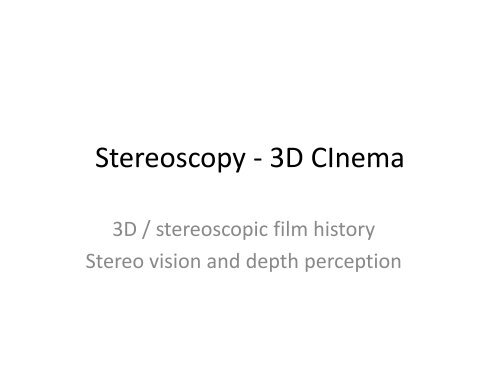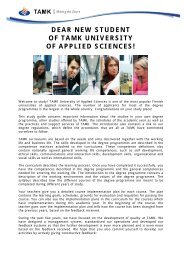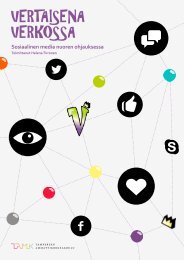Stereoscopy and 3D cinema
Stereoscopy and 3D cinema
Stereoscopy and 3D cinema
- No tags were found...
You also want an ePaper? Increase the reach of your titles
YUMPU automatically turns print PDFs into web optimized ePapers that Google loves.
<strong>Stereoscopy</strong> - <strong>3D</strong> CInema<strong>3D</strong> / stereoscopic film historyStereo vision <strong>and</strong> depth perception
Why is <strong>3D</strong> so much fun?Satisfying an innate human instinct• Predatory nature of the species– FOV - Field of view– Predators require depth to hunt – eyes to the front– Prey require wide angled vision – eyes to the side• Playing with our personal space?
<strong>3D</strong> AND THEFILM INDUSTRY
1950s Golden Age of ‘Naturalvision’– Multicamera filming– 2 film stocks to be played back simultaneously (synced in theprojectors)– Skilled projectionists for effective <strong>3D</strong> viewing– Image quality problems
1960 / 70s revival– Multicamera filming– 2 film stocks to be played back simultaneously (synced in theprojectors)– Skilled projectionists for effective <strong>3D</strong> viewing– Image quality problems
1980s• The IMAX <strong>cinema</strong> theatres• Enhanced the viewingexperience
1990s– Film with digitisation– A digital workflow– Full digital FX
2000’s...• Digital ‘lens to lens’ workflow• Synthetic digital movie making (fully CGI)
Economics of <strong>3D</strong>• A certain amount of <strong>3D</strong> projectors are needed to break even on presenting<strong>3D</strong> movies• Film companies still require 2D simultaneous releaseto be economically viable• Aside from projector limitations, <strong>3D</strong> is in itself economically viable– The polar express <strong>3D</strong> (2003)• Released in 2D• Released in 70 IMAX <strong>cinema</strong>s• Revenue (per copy <strong>3D</strong>:2D) - 14:1
Avatar – Economic milestone2,351,605,000 worldwide box office takings (15 February 2010)81% of that is from the <strong>3D</strong> version• 64% regular <strong>3D</strong> <strong>cinema</strong>• 17% IMAX <strong>cinema</strong>
Stereo vision <strong>and</strong> stereo imageryHow <strong>3D</strong> works
In Short…• Our brain sees one image but it is made up of information from twoimages• These two images (from left <strong>and</strong> right eye) are almost the same• The slight differences tell us a lot about the depth of a scene• These differences become more obvious the closer things are to us– (Fingers example)• Stereoscopic photography uses two cameras representing our eyes, torecord (see) the scene for us• When we watch a stereoscopic film with <strong>3D</strong> glasses, we extract the twoimages from it <strong>and</strong> our brain does the rest…….
Stereopsis <strong>and</strong> stereoscopyStereopsis (natural stereo vision)• Our eyes see the world as 2 individual images (left / right)• Their difference is referred to as disparity• Our 2 ‘eye-images’ are fused into a single stereo imagein our brains<strong>Stereoscopy</strong> (stereo camera imagery)• the production of 2 separate digital images• The digital images are taken at a distance of 2.7” (the same disparity asour eyes)
Shooting StageTwo cameras are placed sideby side, roughly the distancebetween an adults eyes (2.7inches)The images from each camera willhave a slightly different picture
Mixing the viewsThe two separate images arecolourised (left – red, rightcyan)The colourised images arecomposited (mixed together)Where the two images are thesame, the colours are naturallookingWhere the images are different,coloured edges are visible
Viewing Stage<strong>3D</strong> glasses filter the redcomponents to the left eye<strong>and</strong> the cyan components tothe rightNatural stereo vision can nowtake place because the vieweris seeing the scene as twoimagesThe brain re-assembles the twoimages into one stereo image(STEREOPSIS)
Visualizing <strong>and</strong> using disparity
Convergence <strong>and</strong> Accomodation (focusing)• Convergence (coming together)– Our eyes rotate inwards (cross) when looking at an object that is close to us– Our eyes are in parallel when looking into the distance (infinity)• Accomodation (Sharpening)– The muscles that focus the lens of the eye at a particular distance– Accomodating - at a distance(USE FINGER EXAMPLE TO CONVERGE AND ACCOMMODATE)• In <strong>3D</strong> <strong>cinema</strong>, we are converging on objects as if they were between us <strong>and</strong> thescreen or behind the screen but accomodating on the screen
The disparity is forcing eyes to convergeat a point close to usThe brain thinks the object is in front ofthe screen
There is little or no disparityThe brain thinks the object is atthe screen
The disparity is forcing the eyes to converge at adistanceThe object appears to recede behind the screen
InfinityThe left / right disparity doesn’t force anyconversionThe eyes are relaxed <strong>and</strong> facing out in parallelThe brain thinks it is looking at infinityStereopsis doesn’t work at such agreat distance (40Meteres +) <strong>and</strong> we must instead usemonoscopic depth cues to gauge relativedistance
The stereoscopic comfort zoneToo much disparity can beuncomfortableAnd sometimes painful!
Bad <strong>3D</strong>Retinal Rivalry• The on screen disparity is so wide that your brain can no longer fuse theviewpoints into one stereo image• Your eyes (retinas) compete over who gets to look at the image• The image flickers between each view point (L – R)Vertical Disparity• Where the images are not aligned horizontally• Our eyes cannot resolve them vertically (our eyes are horizontally aligned)• <strong>3D</strong> effect fails
Stereoptic depthOcclusion revelation (hiding <strong>and</strong> revealing)• Our eyes see two distinct images• When viewing a scene where one object overlaps anotherwe see a tiny strip of the object throughone eye that is not visible with the other• This strip is the ’occlusion revelation’• Occlusion revelation is key in assessing objectsrelative distance from each other in z space
How is the <strong>3D</strong> effect enhanced?• Traditional film depth + stereoscopic depth• Stereopsis is just one of many ways that we perceive depth• Human adults can still perceive depth with one eye closed• Monoscopic photography can also indicate depth• Monoptic depth cues involve extracting depth information from a 2D view
Monoscopic depth cuesRelative size– Distant = small– Near = big• Dependant on existing knowledge of scale <strong>and</strong> proportion• A small house next to a big person indicates that the person is in the foreground<strong>and</strong> the house is in the backgroundOverlap• Objects obscured by other objects areperceived as background objects– Distant = behind– Near = on front
Monoscopic depth cuesPerspective• Aerial - colours become faded <strong>and</strong> grey as they recede• Linear - Lines converge in the distance• Pattern - Objects get smaller as they recede(Crowd scene)
Monoscopic depth cuesLight <strong>and</strong> shade• Sculpting depth with light• Objects surfaces catch <strong>and</strong> hide from light– Light fades away from its source– Curves gradually fade from light to dark
Monoscopic depth cuesMotion Parallax• Example - The view from a train window (Point Of View Parallax)– The hedges fly past in a blur– The houses move past quite fast– The distant trees move more slowly– The mountains in the background do not seem to move at all– Train video with parallax• Every time you move your head you are experiencing subtle but crucial POVMotion Parallax
Object movement parallax• The farther away an object is, the slower it seems to move– A plane about to take off will seem extremely fast to a nearby viewer– As it takes off at the end of the runway it will appear slower– As it flies off into the distance it will seem slower again– In full flight it will seem to be almost stopped (flying x3 the runway speed)
















